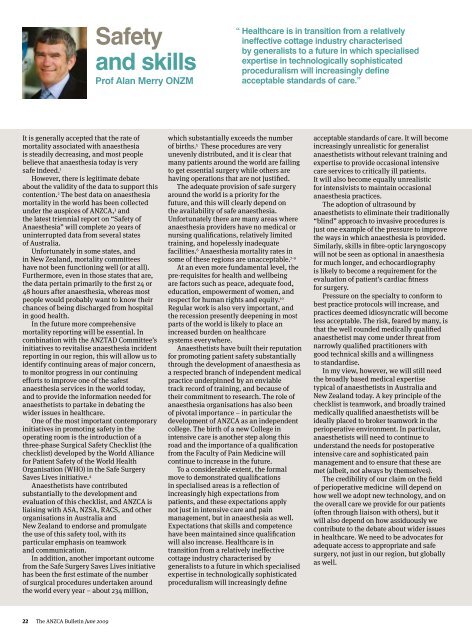ANZCA Bulletin - June 2009 - Australian and New Zealand College ...
ANZCA Bulletin - June 2009 - Australian and New Zealand College ...
ANZCA Bulletin - June 2009 - Australian and New Zealand College ...
- No tags were found...
Create successful ePaper yourself
Turn your PDF publications into a flip-book with our unique Google optimized e-Paper software.
Safety<strong>and</strong> skillsProf Alan Merry ONZM“ Healthcare is in transition from a relativelyineffective cottage industry characterisedby generalists to a future in which specialisedexpertise in technologically sophisticatedproceduralism will increasingly defineacceptable st<strong>and</strong>ards of care.”It is generally accepted that the rate ofmortality associated with anaesthesiais steadily decreasing, <strong>and</strong> most peoplebelieve that anaesthesia today is verysafe indeed. 1However, there is legitimate debateabout the validity of the data to support thiscontention. 2 The best data on anaesthesiamortality in the world has been collectedunder the auspices of <strong>ANZCA</strong>, 3 <strong>and</strong>the latest triennial report on “Safety ofAnaesthesia” will complete 20 years ofuninterrupted data from several statesof Australia.Unfortunately in some states, <strong>and</strong>in <strong>New</strong> Zeal<strong>and</strong>, mortality committeeshave not been functioning well (or at all).Furthermore, even in those states that are,the data pertain primarily to the first 24 or48 hours after anaesthesia, whereas mostpeople would probably want to know theirchances of being discharged from hospitalin good health.In the future more comprehensivemortality reporting will be essential. Incombination with the ANZTAD Committee’sinitiatives to revitalise anaesthesia incidentreporting in our region, this will allow us toidentify continuing areas of major concern,to monitor progress in our continuingefforts to improve one of the safestanaesthesia services in the world today,<strong>and</strong> to provide the information needed foranaesthetists to partake in debating thewider issues in healthcare.One of the most important contemporaryinitiatives in promoting safety in theoperating room is the introduction of athree-phase Surgical Safety Checklist (thechecklist) developed by the World Alliancefor Patient Safety of the World HealthOrganisation (WHO) in the Safe SurgerySaves Lives initiative. 4Anaesthetists have contributedsubstantially to the development <strong>and</strong>evaluation of this checklist, <strong>and</strong> <strong>ANZCA</strong> isliaising with ASA, NZSA, RACS, <strong>and</strong> otherorganisations in Australia <strong>and</strong><strong>New</strong> Zeal<strong>and</strong> to endorse <strong>and</strong> promulgatethe use of this safety tool, with itsparticular emphasis on teamwork<strong>and</strong> communication.In addition, another important outcomefrom the Safe Surgery Saves Lives initiativehas been the first estimate of the numberof surgical procedures undertaken aroundthe world every year – about 234 million,which substantially exceeds the numberof births. 5 These procedures are veryunevenly distributed, <strong>and</strong> it is clear thatmany patients around the world are failingto get essential surgery while others arehaving operations that are not justified.The adequate provision of safe surgeryaround the world is a priority for thefuture, <strong>and</strong> this will clearly depend onthe availability of safe anaesthesia.Unfortunately there are many areas whereanaesthesia providers have no medical ornursing qualifications, relatively limitedtraining, <strong>and</strong> hopelessly inadequatefacilities. 6 Anaesthesia mortality rates insome of these regions are unacceptable. 7-9At an even more fundamental level, thepre-requisites for health <strong>and</strong> wellbeingare factors such as peace, adequate food,education, empowerment of women, <strong>and</strong>respect for human rights <strong>and</strong> equity. 10Regular work is also very important, <strong>and</strong>the recession presently deepening in mostparts of the world is likely to place anincreased burden on healthcaresystems everywhere.Anaesthetists have built their reputationfor promoting patient safety substantiallythrough the development of anaesthesia asa respected branch of independent medicalpractice underpinned by an enviabletrack record of training, <strong>and</strong> because oftheir commitment to research. The role ofanaesthesia organisations has also beenof pivotal importance – in particular thedevelopment of <strong>ANZCA</strong> as an independentcollege. The birth of a new <strong>College</strong> inintensive care is another step along thisroad <strong>and</strong> the importance of a qualificationfrom the Faculty of Pain Medicine willcontinue to increase in the future.To a considerable extent, the formalmove to demonstrated qualificationsin specialised areas is a reflection ofincreasingly high expectations frompatients, <strong>and</strong> these expectations applynot just in intensive care <strong>and</strong> painmanagement, but in anaesthesia as well.Expectations that skills <strong>and</strong> competencehave been maintained since qualificationwill also increase. Healthcare is intransition from a relatively ineffectivecottage industry characterised bygeneralists to a future in which specialisedexpertise in technologically sophisticatedproceduralism will increasingly defineacceptable st<strong>and</strong>ards of care. It will becomeincreasingly unrealistic for generalistanaesthetists without relevant training <strong>and</strong>expertise to provide occasional intensivecare services to critically ill patients.It will also become equally unrealisticfor intensivists to maintain occasionalanaesthesia practices.The adoption of ultrasound byanaesthetists to eliminate their traditionally“blind” approach to invasive procedures isjust one example of the pressure to improvethe ways in which anaesthesia is provided.Similarly, skills in fibre-optic laryngoscopywill not be seen as optional in anaesthesiafor much longer, <strong>and</strong> echocardiographyis likely to become a requirement for theevaluation of patient’s cardiac fitnessfor surgery.Pressure on the specialty to conform tobest practice protocols will increase, <strong>and</strong>practices deemed idiosyncratic will becomeless acceptable. The risk, feared by many, isthat the well rounded medically qualifiedanaesthetist may come under threat fromnarrowly qualified practitioners withgood technical skills <strong>and</strong> a willingnessto st<strong>and</strong>ardise.In my view, however, we will still needthe broadly based medical expertisetypical of anaesthetists in Australia <strong>and</strong><strong>New</strong> Zeal<strong>and</strong> today. A key principle of thechecklist is teamwork, <strong>and</strong> broadly trainedmedically qualified anaesthetists will beideally placed to broker teamwork in theperioperative environment. In particular,anaesthetists will need to continue tounderst<strong>and</strong> the needs for postoperativeintensive care <strong>and</strong> sophisticated painmanagement <strong>and</strong> to ensure that these aremet (albeit, not always by themselves).The credibility of our claim on the fieldof perioperative medicine will depend onhow well we adopt new technology, <strong>and</strong> onthe overall care we provide for our patients(often through liaison with others), but itwill also depend on how assiduously wecontribute to the debate about wider issuesin healthcare. We need to be advocates foradequate access to appropriate <strong>and</strong> safesurgery, not just in our region, but globallyas well.22The <strong>ANZCA</strong> <strong>Bulletin</strong> <strong>June</strong> <strong>2009</strong>
















